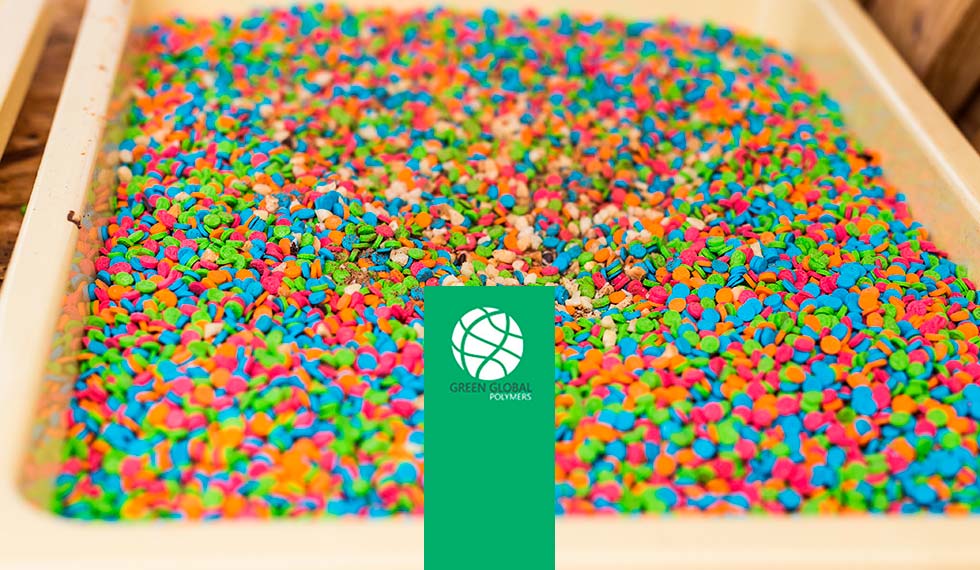
La granza reciclada es un tipo de materia prima secundaria que se obtiene mediante el proceso de reciclaje de plásticos post-consumo o post-industrial. Se presenta en forma de pequeños pellets o gránulos y se utiliza como insumo en la fabricación de nuevos productos plásticos. Es la alternativa directa al uso de plástico virgen, pero con un impacto ambiental significativamente menor.
En un contexto global cada vez más afectado por la contaminación plástica, los desechos mal gestionados y la creciente presión sobre los recursos naturales, el uso de granza reciclada se posiciona como una solución estratégica para la industria. No solo porque evita el consumo de recursos fósiles, sino porque también reduce emisiones, promueve la economía circular y alarga el ciclo de vida del material.
En Green Global Polymers, creemos firmemente que el plástico no debe ser un desecho de un solo uso, sino un recurso con múltiples vidas. Por eso, cada tonelada de granza reciclada que producimos es un paso más hacia un mundo más sostenible.
Cómo se produce una tonelada de granza reciclada
El proceso para obtener una tonelada de granza reciclada comienza con la recuperación de residuos plásticos, principalmente procedentes del contenedor amarillo, industrias y empresas que gestionan grandes volúmenes de plástico.
En nuestra planta de Green Global Polymers, ubicada en Ribarroja del Túria (Valencia), contamos con una línea de lavado y triturado de alta eficiencia. Este sistema nos permite transformar residuos plásticos en dos productos reutilizables: plástico triturado y granza reciclada.
El proceso incluye:
- Clasificación: separación por tipo de plástico (PP, PEHD, PELD, PET, PVC, PS).
- Triturado: reducción del tamaño del material para facilitar su limpieza.
- Lavado: eliminación de impurezas, etiquetas, restos orgánicos.
- Secado y extrusión: el material limpio se funde y se extruye para formar los pellets.
- Corte y enfriado: el plástico fundido se corta en pequeñas unidades —la granza— y se enfría.
Este ciclo, aunque técnico, es altamente eficaz para valorizar residuos y convertirlos en materia prima útil. Y lo más importante: permite reducir drásticamente el impacto ambiental en comparación con la producción de plásticos vírgenes.
¿Cuánto ahorra una tonelada de granza reciclada?
Una de las preguntas más importantes que nos hacen tanto clientes como instituciones es: ¿Qué impacto tiene realmente una tonelada de granza reciclada?
Numerosos estudios han demostrado que reciclar una tonelada de plástico en lugar de producirla desde cero implica:
- Entre un 60% y 75% menos de emisiones de CO₂.
- Un ahorro de aproximadamente 5.774 kWh de energía (suficiente para abastecer a un hogar medio durante 6 meses).
- La reducción de aproximadamente 700 kg de petróleo bruto necesarios para fabricar plástico virgen.
- Evita la generación de residuos sólidos no biodegradables que tardarían siglos en degradarse.
En Green Global Polymers, sabemos que cada tonelada cuenta. Cuando procesamos PVC o polietileno recuperado, no solo obtenemos plásticos reciclados de calidad, sino que contribuimos directamente a reducir la huella de carbono de todo el sector.
Comparativa ambiental, granza reciclada vs. plástico virgen
La diferencia entre utilizar granza reciclada y producir plástico virgen es abismal desde el punto de vista ambiental.
Plástico virgen:
- Se fabrica a partir de recursos fósiles (gas natural, petróleo).
- Su producción emite grandes cantidades de dióxido de carbono.
- Requiere más energía y agua.
- Genera residuos industriales no siempre gestionados de forma óptima.
Granza reciclada:
- Proviene de residuos ya existentes.
- Evita la extracción de nuevas materias primas.
- Requiere menos energía para su transformación.
- Disminuye la presión sobre vertederos e incineradoras.
En términos generales, usar granza reciclada puede reducir las emisiones hasta en un 70% respecto al uso de plásticos vírgenes. Este dato convierte a la granza reciclada en una de las formas más efectivas y directas de mejorar el desempeño ambiental de las industrias que usan plásticos.
Beneficios ambientales del reciclaje de plásticos
Hablar del reciclaje de plásticos es hablar de beneficios múltiples:
- Reducción de emisiones: cada tonelada reciclada evita toneladas de gases de efecto invernadero.
- Conservación de recursos: el plástico reciclado sustituye materias primas fósiles.
- Ahorro energético: menos procesos industriales intensivos.
- Prevención de contaminación: menos residuos terminan en ríos, mares o suelos.
- Fomento de la economía circular: promueve un modelo de consumo más sostenible.
En Green Global Polymers estamos convencidos de que reciclar no es solo una opción: es una obligación ética y ambiental. Por eso, nos esforzamos cada día para que más toneladas de plástico encuentren una nueva vida útil.
Economía circular y reducción de emisiones, el futuro del plástico
La economía circular no es una moda pasajera. Es el futuro del desarrollo industrial sostenible.
La idea de ciclo cerrado, en la que los materiales se recuperan, transforman y reutilizan de forma constante, permite:
- Evitar el agotamiento de recursos.
- Reducir los residuos industriales.
- Estabilizar los costos de producción.
- Disminuir la dependencia energética de combustibles fósiles.
En este marco, el uso de granza reciclada es una pieza fundamental. Cada vez más empresas del sector packaging, automoción, construcción o sanitario están incorporando plástico reciclado en sus procesos.
Green Global Polymers, con sus décadas de experiencia, forma parte activa de este cambio. Sabemos que cada pequeño gesto, desde separar bien los residuos hasta transformar el material en nuestra planta, tiene un efecto real en la lucha contra el cambio climático.
Compromiso de Green Global Polymers, reciclaje con propósito
Como empresa familiar con más de 30 años en el sector del reciclaje de plásticos, en Green Global Polymers apostamos por un modelo de gestión responsable, donde el reciclaje se convierte en motor de cambio.
Trabajamos con distintos materiales como PP, PEHD, PELD, PET, PVC y PS, y contamos con una planta dotada de tecnología para garantizar productos reciclados de calidad.
Nuestra línea de triturado y lavado permite cerrar el ciclo de vida de muchos residuos plásticos. Gracias a este proceso, generamos dos productos estrella:
- Plástico triturado, listo para nueva transformación.
- Granza reciclada, que retorna a la cadena de valor como insumo limpio y útil.
Además, impulsamos la concienciación ciudadana. Sabemos que sin la colaboración de quienes reciclan cada día en el contenedor amarillo, nuestra labor no tendría sentido.
Hacia un modelo de producción más responsable y sostenible
El impacto ambiental de cada tonelada de granza reciclada no puede medirse solo en cifras: debe medirse también en esperanza. Cada vez que un residuo plástico evita el vertedero y se convierte en granza, estamos dando un paso más hacia un mundo donde los recursos no se malgastan, sino que se transforman.
En Green Global Polymers, creemos en un futuro donde el plástico no sea el enemigo, sino parte de la solución. Un futuro donde la industria, el consumidor y el medio ambiente trabajen en armonía.
Y sobre todo, un futuro donde cada tonelada cuente. Porque contar sí que cuenta.



